Contents
HELMET IMPORTANCE
Wearing a helmet while riding a motorcycle is crucial for protecting yourself in the event of an accident. A helmet can significantly reduce the risk of injury and death by absorbing the impact and protecting your head and brain. It is important to choose a helmet that meets or exceeds safety standards set by the government, is made of high-quality materials, is comfortable to wear and has a good fit.
When it comes to helmets, it’s not a matter of style or preference, it’s a matter of safety. Always wear a helmet every time you ride and make sure that it is fastened properly. Remember, a helmet is not only important for yourself but also for your loved ones, it is a small investment for a big reward: your life.
TYPES OF HELMETS
There are 6 types of motorcycle helmets
- Full-Face Helmet
- Half-Face Helmet
- Modular Helmet
- Half Shell Helmet
- Off-Road Helmet
- Dual Sport Helemet
Full-Face Helmet
A full-face helmet is a type of motorcycle helmet that covers the entire head, including the chin and face. It is the most protective type of helmet available and is designed to provide maximum coverage and safety for the rider.
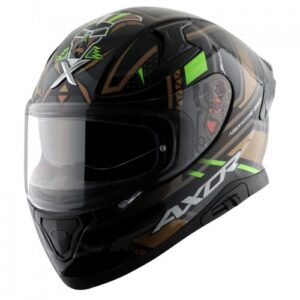
Half-Face Helemt
A half-face helmet, also known as a three-quarters helmet, is a type of motorcycle helmet that covers the top and back of the head, but leaves the face and chin exposed. It is less protective than a full-face helmet, but it is also less restrictive.
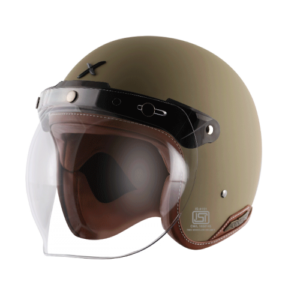
Modular Helmet
A modular helmet is a type of motorcycle helmet that allows the rider to easily remove the chin bar of the helmet, converting it from a full-face helmet to an open-face helmet. This allows for greater versatility and convenience, as the rider can easily switch between full-face protection and an open-face configuration that allows for more airflow and easier communication with others.
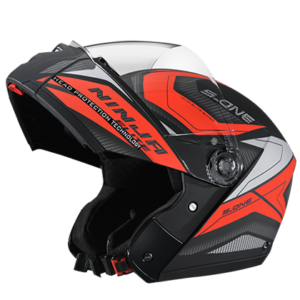
Half-Shell Helemt
A half-shell helmet is a type of motorcycle helmet that covers the top of the head and the back of the head, but leaves the face exposed. These helmets are typically lighter and more compact than full-face helmets, and they allow for more airflow to the face, which can be beneficial in hot weather. They offer less protection than full-face helmets as they don’t cover the chin and the face, and are typically used for cruiser, scooter and adventure touring riders.
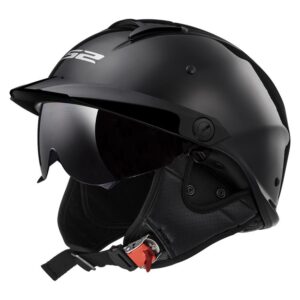
Off-Road Helmet
An off-road helmet is a type of helmet specifically designed for use in off-road and motocross riding. Off-road helmets typically feature a distinctive, elongated chin guard and a visor, which can be adjusted or removed as needed. The elongated chin guard provides additional coverage for the chin and jaw, which can be especially important in off-road riding, where debris and branches can be kicked up by the tires. They are also designed to withstand impact better and provide better ventilation than street helmets. They also have a peak to protect the rider from the sun and other elements.
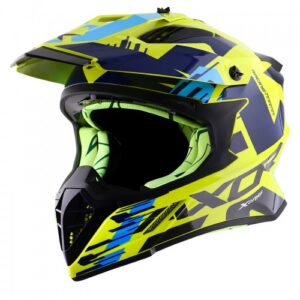
Dual Sport Helemet
A dual-sport helmet is a type of motorcycle helmet that is designed for use in both on-road and off-road riding. These helmets are typically a combination of a full-face street helmet and an off-road helmet, featuring elements of both designs such as a visor and a peak. They usually have a flip-up face shield and a sun visor, and often have a more aerodynamic shape and a ventilation system that is optimized for high-speed riding on pavement. They also have a peak like off-road helmets to protect the rider from the sun and other elements.
Dual-sport helmets are designed to provide the best of both worlds: the protection of a full-face helmet and the versatility of an off-road helmet, making them a popular choice for riders who do a mix of street and off-road riding.
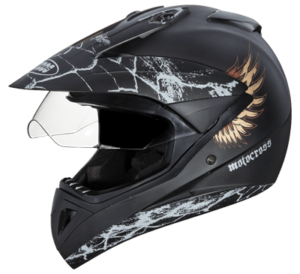
What are the meterials used in Helmet
Helmets are typically made from a combination of different materials, each of which serves a specific purpose. The most common materials used in helmet construction are:
Polycarbonate: A strong, lightweight plastic that is used as the outer shell of many helmets. It is highly impact-resistant and helps to distribute the force of a blow across the surface of the helmet.
Expanded Polystyrene (EPS): A lightweight foam that is used as the impact-absorbing liner of many helmets. EPS is a highly effective shock absorber and is used to protect the head from the effects of a crash.
Fiberglass: A strong, lightweight material that is often used in combination with polycarbonate or other materials to make the outer shell of a helmet.
Carbon Fiber: A strong, lightweight material that is used to make the shell of some high-end helmets. Carbon fiber is even stronger and more impact-resistant than fiberglass, but it is also more expensive.
Kevlar: A strong, lightweight material that is often used in combination with other materials to make the outer shell of a helmet. Kevlar can add extra strength and impact resistance to a helmet.
Leather : Some full-face helmets have leather chin strap and padding for extra comfort and style.
It’s important to note that different helmets use different combinations of materials, and the specific materials used will depend on the intended use of the helmet and the level of protection it is designed to provide.
Select Good Comfort Helmet
Comfort is an important aspect to consider when choosing a helmet, as a helmet that is uncomfortable to wear will not be worn as often or as consistently as one that is comfortable. Here are a few factors that can affect a helmet’s comfort:
Fit: The most important factor in a helmet’s comfort is that it fits well. A helmet that is too tight or too loose will be uncomfortable to wear, and may also provide less protection.
Weight: A heavy helmet can be tiring to wear, especially on long rides. Lightweight helmets are generally more comfortable to wear.
Ventilation: Helmets with good ventilation will help to keep the head cool and dry, which can make a big difference in terms of comfort.
Padding: A helmet with soft, high-quality padding will be more comfortable to wear than one with hard, low-quality padding.
Chin strap: A helmet’s chin strap should be comfortable and easy to adjust, in order to ensure that the helmet stays securely in place.
Earpads: Some helmets have earpads which will help reduce wind noise and make it more comfortable to wear for long periods of time.
Visor: Some helmets have an adjustable visor that can be moved up or down to protect the rider from sun and wind.
Interchangeable padding: Some helmets have removable and washable padding which can help to maintain hygiene and comfort.
It’s a good idea to try on a few different helmets and compare their comfort levels before making a purchase. And also, it’s important to note that the level of comfort can vary from person to person and what may be comfortable for one person may not be for another, so it’s important to try them on before buying.
FAQs
How to Choose a Perfectly Sized Helmet?
Choosing the right size helmet is essential for both safety and comfort. Most helmet manufacturers provide a size chart on their website It should fit snugly, but not too tight. The helmet should sit level on your head and the front of the helmet should be about an inch above your eyebrows.
You can pick a good helmet depending upon your budget, and spending a huge sum on an international brand may not always be worth it. The main factors you should consider are the safety and comfort offered by the helmet.
It is not recommended to buy an uncertified helmet. Not only it’s illegal to wear an uncertified helmet in some places, but it also puts your safety at risk. It’s always better to invest in a certified helmet that will give you the peace of mind that your head is protected.
Helmet Safety Rating and Certifications?
- ISI (Indian Standards Institution) in India
- DOT (Department of Transportation) in the United States
- ECE (Economic Commission for Europe) in Europe
- Snell Memorial Foundation
- SHARP (Safety Helmet Assessment and Rating Programme) in the UK
I enjoyed reading your piece and it provided me with a lot of value.
I want to thank you for your assistance and this post. It’s been great.